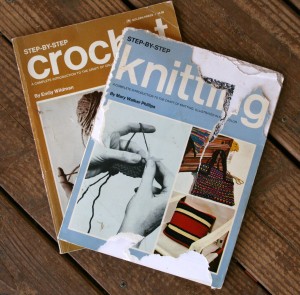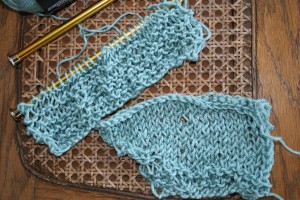 I have found that I need to keep my mind engaged with something new, and creating small challenges for myself is the best way for me to feel fulfilled and whole. When I focus this on my work in crochet it has usually been that challenge of “what can I create with this one skein of yarn”, or “how can I put this together differently”. However, this last week I took myself outside my comfort zone, it may seem a little sacrilegious, but I picked up a book and have begun teaching myself the basics of knitting. I know some out there are silently cheering that they have “converted me” and some are sighing that “I’ve gone to the dark side”, but neither could be further from the truth…this is just about a mental expansion.
I have found that I need to keep my mind engaged with something new, and creating small challenges for myself is the best way for me to feel fulfilled and whole. When I focus this on my work in crochet it has usually been that challenge of “what can I create with this one skein of yarn”, or “how can I put this together differently”. However, this last week I took myself outside my comfort zone, it may seem a little sacrilegious, but I picked up a book and have begun teaching myself the basics of knitting. I know some out there are silently cheering that they have “converted me” and some are sighing that “I’ve gone to the dark side”, but neither could be further from the truth…this is just about a mental expansion.

The books I learned to crochet and knit with. The knitting book has seen better days, but the house rabbit didn’t finish it off!
I have been crocheting for so much of my life, that I don’t know if I have a memory before I picked up a hook, but knitting was never something that I tried. When I learned to crochet, it was from a book, a Step-by-Step guide book printed by Golden Press in 1967. At the time I received this book, in a box of other books from a family member, there was a knitting book from the same publication (I think there may have been a macrame as well as some paper dolls and coloring books, it was quite a little assortment). I never really paid the knitting book much attention, I know my sister picked it up at one point years later and learned the basics of knitting (although I think her heart is into needle felting and sewing at this time in history).
So the book was just “around”, well I picked it up this week and gave it a go. The smallest needles I have in the house were 10mm, as I usually only use one and that is for broomstick lace. Well I managed to find a pair, and began to cast on. I have heard horror stories from knitters about casting on, but working different techniques in crochet made this feel natural (at least if I did it correctly, but it looks good so far). I believe the cast on I did would be referred to as the “long tail cast on”, and then I proceeded to work the knitting and purling stitches.
I will admit, I have found this to be a little awkward, I am not quite sure how to hold the needles so that they fell comfortable to me, the needle that I am working loops off of just isn’t sure where it should be. I am constantly fearful that those little loops will jump off the needle and then I will have a mess. But I will admit, it has been a good mental exercise for me.
I decided to give knitting a try for a couple of reasons, for one I have been teaching more often at knitting groups interested in learning some crochet skills such as Tunisian. By understanding the process they are use to it makes it easier to explain. Another reason was to better understand my crochet. So what I have managed to learn in the last week: That loops of either working method really adds the “bounce” to the fabric. These loops (the primary work of all stitches in knitting, but the loops that are pulled through on the crochet hook) are the essence of the yarn itself. If you begin with a yarn that is “springy” or is “stiff”, the loops are the parts of the stitch that highlight this quality. Granted, drape of a fabric can be affected by the hook or needle size being used, but the yarn will always shine through and these loops is where it happens.
Understanding the relationship of the stitch process and the yarn nature really helps to define and appreciate the techniques and the end fabric. This is an enlightening adventure…I wonder where it might take me next….

